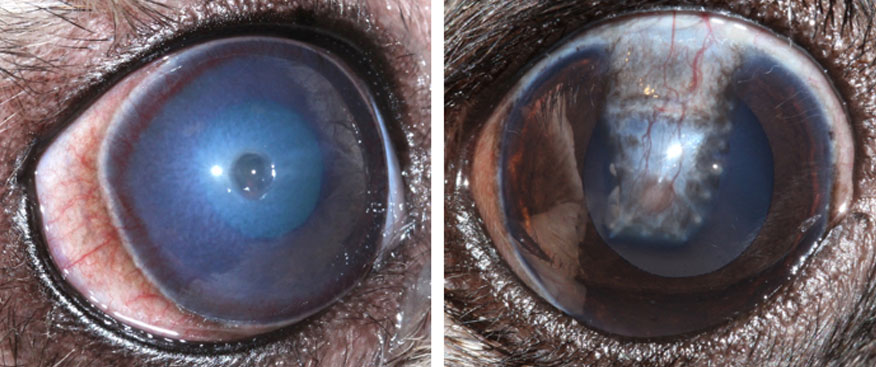Corneal ulcers
The cornea covers the front part of the eye. It is transparent in normal conditions, to allow the passage of light into the eye. The eyelids cover the cornea to protect it against trauma, as well as spreading the tears over the cornea. Tears are also very important in corneal health!
The outermost layer of the cornea is called epithelium. The epithelium could be considered the “skin of the eye”. When this epithelium is missing is when a corneal ulcer appears. Corneal ulcers commonly occur in animals. The cornea is rich in nerves, subsequently when the epithelium is missing this nerves will be irritated and our patients will present ocular discomfort, excessive blinking and tearing.

What causes corneal ulcers?
There are several reasons why corneal ulcers appear. Most ulcers in dogs and cats are the result of trauma – i.e. scratches during walks, thorns, playing or scratches from other animals. Other causes of ulceration are dry eye, eyelid anomalies (entropion, ectopic cilia) or primary abnormalities of the cornea – like spontaneous chronic corneal epithelial defects (SCCED). In cats, feline herpesvirus is often associated with corneal ulcers.
What is the treatment?
Most ulcers will heal without complications within a week. Antibiotic eye drops or ointment will be enough to allow the cornea to heal, as long as the primary cause of the ulcer is no longer present.
When is surgery necessary?
Unfortunately sometimes eye drop(s) are not enough to allow a ulcer to heal. Some examples are: ulcers secondary to an eyelid abnormality, foreign body retained after a trauma (thorn), SCCED or melting ulcers.
Secondary to eyelid abnormality
Surgery to correct the primary eyelid problem will be necessary to allow corneal healing.
Corneal foreign body retention
If your pet has developed a corneal ulcer secondary to bumping into a bush, small pieces of foreign bodies may be required to be removed surgically.
Spontaneous chronic corneal epithelial defect (SCCED)
This type of ulcers occur more commonly in elderly dogs. They are secondary to an abnormal cornea that does not allow correct corneal healing. Dogs suffering this condition will present recurrent ulcerations that fail to heal. Corneal burring or debridement under topical anaesthesia will be necessary for this ulcers to successfully heal. However, some cases will require surgical removal of the abnormal area under general anaesthesia to achieve complete healing.
Melting ulcers
This type of ulcers occur most commonly when an infection settles in the ulcerated cornea. The lack of epithelium (skin of the eye) will allow bacteria to contact the unprotected cornea. Bacteria can deepen the ulcer increasing the risks of rupture of the globe. Surgical repair techniques may be necessary.
To find out more about corneal surgical repair, click here
